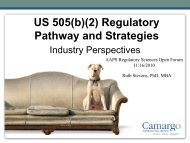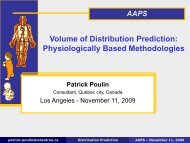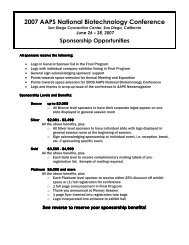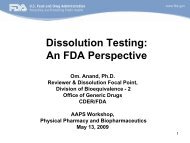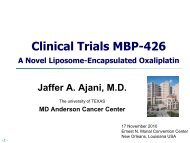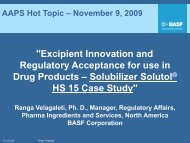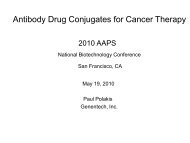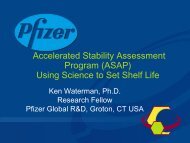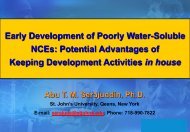Preliminary Program - American Association of Pharmaceutical ...
Preliminary Program - American Association of Pharmaceutical ...
Preliminary Program - American Association of Pharmaceutical ...
You also want an ePaper? Increase the reach of your titles
YUMPU automatically turns print PDFs into web optimized ePapers that Google loves.
73<br />
2009 AAPS Annual Meeting and Exposition<br />
AAPS Pharmacokinetics, Pharmacodynamics and Drug Metabolism (PPDM) <strong>Program</strong>ming<br />
Microdialysis in Skin: Overview and<br />
Comparison with Other Techniques<br />
Chris D. Anderson, M.D.<br />
Linköping University<br />
Microdialysis in the Selection <strong>of</strong> Optimal<br />
Formulations for Iontophoretic Drug Delivery<br />
Grazia Stagni, Ph.D., M.S.<br />
Long Island University<br />
Determination <strong>of</strong> Drug Penetration in<br />
Diseased Skin<br />
Speaker to be Determined<br />
The Regulatory View Point<br />
Edward Bashaw, Pharm.D., invited<br />
U.S. Food and Drug Administration<br />
2:00 pm – 4:30 pm<br />
The Graying Globe — Drug Development<br />
in the Elderly<br />
Symposium<br />
The U.S. Food and Drug Administration Guidance<br />
for Industry for the study <strong>of</strong> drugs likely to be used<br />
in the elderly was first published in 1989 and was<br />
followed by the Guideline for Industry for Studies in<br />
Support <strong>of</strong> Special Populations: Geriatrics in 1994.<br />
The corresponding ICH guidance was published the<br />
same year. In the 15 years since that time, so many<br />
new tools useful in clinical pharmacology have been<br />
developed, and so much data on drug use in the<br />
elderly have been collected. With the Baby Boom<br />
generation entering their senior years, and with the<br />
large increase in the number <strong>of</strong> the individuals in<br />
their 80’s and 90’s, as well as the large increase<br />
in age-related morbidity associated with cancer<br />
and Alzheimer’s disease, it is time to review our<br />
understanding <strong>of</strong> the issues <strong>of</strong> drug development<br />
and the elderly. The topics to be discussed include<br />
current and projected demographic statistics<br />
including anticipated consumption <strong>of</strong> medical and<br />
pharmaceutical services, physiology <strong>of</strong> healthy aging<br />
as well as disease progression in the elderly, study<br />
design issues in phase 1, 2, and 3 associated with<br />
the elderly — including appropriate comparisons,<br />
and summarization <strong>of</strong> data to link what is learned<br />
in the young healthy volunteers to what is actually<br />
happening in the elderly receiving the drug; dosage<br />
form considerations for the elderly. At the end <strong>of</strong> the<br />
session, participants will understand the increasing<br />
number <strong>of</strong> elderly, especially those older than 75<br />
years <strong>of</strong> age, and the magnitude <strong>of</strong> the demand for<br />
clinical and pharmaceutical services in the next 25<br />
years; be able to describe the physiological changes<br />
associated with aging as well as those associated<br />
with common disease progression and the<br />
interaction; and be able to formulate a strategy for<br />
study design, analysis, and interpretation to develop<br />
the information needed to demonstrate exposure<br />
effect relationships in the elderly and other patients<br />
likely to receive medications.<br />
Moderators<br />
Vijay Tammara, Ph.D., M.Pharm.<br />
Merck and Co., Inc.<br />
Joan M. Korth-Bradley, Pharm.D., Ph.D., R.Ph.<br />
Wyeth Research<br />
Physiological Changes Associated with Aging<br />
and Aging-related Disease<br />
James E. Tisdale, Pharm.D.<br />
Purdue University<br />
Implications <strong>of</strong> Aging on Clinical<br />
Pharmacology: Regulatory Perspective<br />
Chandrahas G. Sahajwalla, Ph.D., invited<br />
U.S. Food and Drug Administration<br />
Implications <strong>of</strong> Aging on Clinical<br />
Pharmacology: <strong>Pharmaceutical</strong> Industry<br />
Perspective<br />
Vijay Tammara, Ph.D., M.Pharm.<br />
Merck and Co., Inc.<br />
Thursday, November 12, 2009<br />
THURSDAY SUNRISE SESSIONS<br />
7:00 am – 8:15 am<br />
Humanized Transgenic Transporter<br />
Models — Update on State-<strong>of</strong>-the-Art<br />
Sunrise Session<br />
This sunrise session will provide up-to-date<br />
information on the state <strong>of</strong> the art with the various<br />
humanized transporter models. The human<br />
relevance <strong>of</strong> transporter based DDI’s can benefit via<br />
development <strong>of</strong> such humanized transporter models<br />
that expresses human transporters in animal<br />
models. The session will provide insights into all<br />
aspects <strong>of</strong> these project’s background, rationale,<br />
challenges, strategies, models, validations,<br />
implementation, future direction, etc. Leading<br />
scientists from academia and industry will be<br />
presenting the overview, as well as, the practical<br />
relevance <strong>of</strong> the humanized transporter models in<br />
drug discovery and development. Emphasis will<br />
be on the practical, and bottom line relevance <strong>of</strong><br />
these models in facilitating clinical relevance <strong>of</strong><br />
transporter based DDI’s.<br />
Moderator<br />
Praveen Balimane, Ph.D.<br />
Bristol-Myers Squibb<br />
Humanization Approaches: Technology and<br />
Strategic Approaches<br />
Kader Thiam, Ph.D.<br />
Gelita AG, Eberbach, Germany<br />
Use <strong>of</strong> Humanized Transporter Mice Models:<br />
ADME Applications<br />
Nico Scheer, Ph.D.<br />
Galderma<br />
7:00 am – 8:15 am<br />
Physiologically Based Pharmacokinetic<br />
Modeling: Concepts and Applications in<br />
Drug Discovery and Development<br />
Sunrise Session<br />
This session will discuss the generic framework<br />
<strong>of</strong> Physiologically Based Pharmacokinetic (PBPK)<br />
models, and their applicability in drug discovery and<br />
development. In comparison to non-compartmental<br />
and compartmental approaches used routinely in<br />
drug discovery and development Physiologically<br />
Based Pharmacokinetic modeling (PBPK) provides<br />
a more mechanistic and physiological approach<br />
for integrating data and generating knowledge.<br />
Although, PBPK modeling has long been proposed<br />
as a modeling option, its application has only<br />
increased recently, in part, due to availability <strong>of</strong> in<br />
silico/in vitro prediction tools and generic easy-touse<br />
PBPK s<strong>of</strong>tware. Over the past decade, multiple<br />
publications in both academia and industry have<br />
demonstrated the applicability <strong>of</strong> PBPK modeling in<br />
drug discovery and development. These applications<br />
range from use <strong>of</strong> PBPK models for candidate<br />
nomination in drug discovery, prediction <strong>of</strong> human<br />
pharmacokinetics from preclinical species, to<br />
clinical study design and efficacy predictions in<br />
drug development. This sunrise session intends to<br />
present the basic framework <strong>of</strong> generic PBPK models<br />
commonly used in literature and discuss selected<br />
case studies <strong>of</strong> their applicability in preclinical and<br />
clinical studies.<br />
Moderator<br />
Anjaneya P. Chimalakonda, Ph.D.<br />
Bristol-Myers Squibb<br />
Generic Physiologically Based<br />
Pharmacokinetic Models: Conceptual<br />
Framework<br />
Peter F. Thiel, Ph.D.<br />
Genentech, Inc.<br />
Selected Case Studies on Application <strong>of</strong> PBPK<br />
Modeling in Preclinical and Clinical Studies<br />
Thierry Lave, Ph.D.<br />
F. H<strong>of</strong>fmann-La Roche Ltd.





